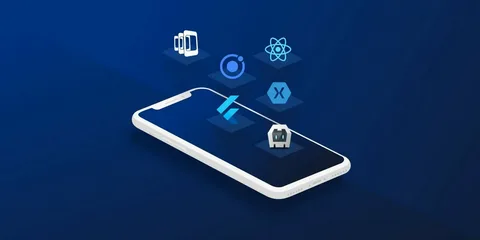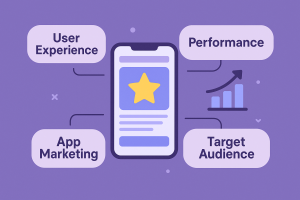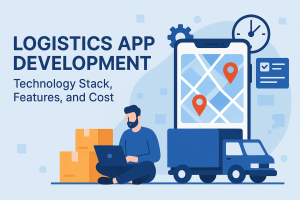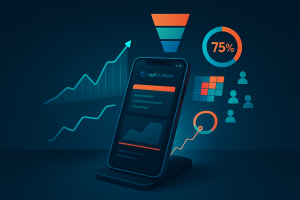If you are a novice app developer and have recently joined the app development industry, you might have limited knowledge about app development and the architectural patterns employed in app development. Learning about mobile app architecture has become significant for app developers nowadays. Robust and agile application frameworks, components, and different layers facilitate app developers in structuring, designing, and testing the application. Knowing about the architectural patterns, models, designs and other components improves the organization and configuration of the application and helps build a robust mobile application ecosystem.
Understanding the app architecture relates to knowing the functional components of the app. The navigation of app structures allows system programmers to know the operational functions of different components. UI, database, APIs, UI/UX design interface, and other interactive elements execute effective coding and data processing. Define and implement operation management and improve app computability. A sturdy structure ensures the scalability, and efficiency of mobile applications, thus, offering intuitive, and seamless app functioning.
Overview of Mobile App Architecture

Mobile app technology has driven the global Mobile App Development market. With around 7 billion smartphone users, the mobile technology is expected to reach 7.7 billion by 2028. The mushroom growth of smartphones and technological advancements has led to the expansion of numerous mobile applications in the market. Consequently, mobile application programmers employ technology trends in designing and creating exclusive mobile applications that are compatible with mobile devices. It signifies developers focus on improving the app architecture by employing innovative features and functionalities that maximize the app’s performance.
If you are planning to develop an app, you must know mobile app architecture – its layers, and components!
An app architecture refers to the structural design and organization of a mobile application. It involves various components such as user interface (UI) design, backend services, APIs, data management, and other processors that manage code and resource sharing. The app architecture comprises a collection of UI/UX, data flow, tech stack, and frameworks that lead to a quick and smooth app development process. The architecture diagram displays a visual representation of the app’s structure. It demonstrates the presentation layer, business, and data layers, and other components that seamlessly work and perform various functions. Each layer executes specific purposes such as app designing, development and testing, data processing, and optimizing the internal and external operating system performance.
The presentation layer
The presentation layer forms a key part of Mobile app development architecture. The layer demonstrates a visual representation of the app. The presentation layer consists of a user interface, screens, navigational buttons, and visual elements that boost users’ interaction with the app. The presentation layer formed from the UI/UX framework focuses on creating visually appealing apps for the end users. The UI design elements encompassing buttons, themes, color, fonts, images, animation, and graphical elements help develop the striking architecture of the app. An aesthetically pleasing and intuitive interface engages users and provides a smooth app navigational experience.
Data layer
The data access layer integrates data access components, data utilities, and service agents. The data access components act as a link between server infrastructure and other core services and ensure smooth data storing, processing, and transmission of data across various digital platforms. Synchronization with other layers increases system speed and efficiency. Moreover, the data layer working with other internal and external operating systems optimizes database query performance. The data layer helps make a database query faster and ensures safe and secure data storage. It effectively manages queries, caching, and other data access mechanics.
Business Logic Layer
The business logic layer is an essential component of mobile app architecture that deals with database management systems. Executing the business logic of an application, the business layer placed between the presentation layer and the data access layer manages data processing and manipulating data. The layer combines and translates all data formats into suitable and compatible formats before it is accessible to the user or stored in the database. The business logic layer defines how operating systems and devices encode, and compress data to ensure secure and encrypted transfer of data across different networks. Following business logic practices, the app developers write complex business codes and processes to create and modify data.
From data processing to transmitting, adding UI elements to the interface, and writing clear and legible codes mobile application architecture ensures a clear and seamless transition between layers. The layers perform key functionalities of building strong responsive apps with unique architecture design, quick load time, and high app speed.
Why is Mobile App Architecture Crucial for App Development?
Maximize the Performance of the mobile app
The architecture of mobile application development plays a crucial role in enhancing app performance and speed. By implementing specific architectural patterns, developers improve responsiveness and streamline development processes. The fundamental components of app architecture comprising the presentation layer, business logic, and data layer accelerate app development process. The designers create striking user-friendly interfaces, reuse code, reduce app development and testing errors, and help create smooth-functioning apps.
A well-designed mobile architecture builds a compatible app
The compatibility feature allows apps to run on numerous platforms without interruptions. Architectural patterns significantly help create compatible apps that seamlessly run on different devices and operating systems. Several architecture layers such as the Model View Model (MVVM) architecture, Middleware architecture, and Model-View-Controller (MVC) make the app compatible with diverse systems. Compatibility through unified architecture model processes and transfer of data smoothly through the user interface and other systems. A compatible interface with appropriate navigational elements such as buttons, suitable font size, and proportionate screen size and resolution of the device allows users to have smooth navigation across multiple devices and browsers. Compatibility testing framework increases app accessibility and yields a superior user experience.
Scalability
The scalability of the app demonstrates the app’s ability to handle an increasing workload of an extensive audience. Scalability increases the app’s long-term viability and extends the user base. High app scaling allows businesses to improve the app’s infrastructure to support a large number of user requests without a minimum delay. A high-performing scalable app handles a bigger load through network congruence, enabling data to securely reach different devices and networks. Hence, app scalability seamlessly manages several requests by optimizing the database and implementing a load-balancing mechanism.
Choosing the Right Architecture Pattern for Mobile Application
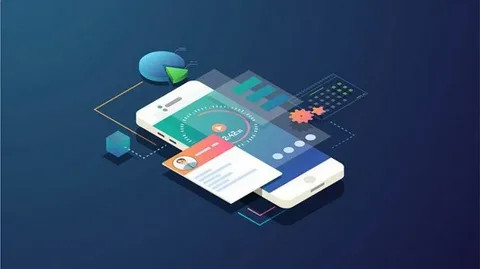
Popular Architecture Patterns
- MVC (Model-View-Controller)
MVC is used to design simple applications. The framework includes three components. The model deals with the app’s business logic and manages data processing functions. The second part, View handles UI elements by creating a striking user interface. The architecture pattern boosts user interaction, allowing users to conveniently navigate the app. The last component, the Controller intercedes between view and model to process incoming user’s requests. Thus, the three components facilitate app developers with a quick development process and ensure that app tests maintain high-quality standards.
- Model View Presenter (MVP)
The architecture pattern includes a component, a presenter that regulates all functions. Similar to MVC, this model also manages the data management process. The key purpose of MVP is to ensure secure data processing, and transferring to different networks and devices. Moreover, the presenter updates the data input received from users through view.
- Model-View-View Model (MVVM)
The process of MVVM and MVC are similar as both models manage data processing and control systems. The View-Model efficiently separates an application’s business and presentation logic from its user interface. This process leads to smooth app development and testing. Moreover, MVVM also assists UI designers in debugging and code reusability process.
Mobile app designers who desire to choose an efficient architectural pattern for building unique apps should know the benefits of different architectural patterns. If you plan to create a simple and easy application for the users, you can employ, the Model-View-Controller framework. Model View View Model and, Model-View-Presenter facilitate formulating apps with more complex functions including intricate data processing and manipulation. The frameworks optimize resource practice, increase communication between different layers, improve cloud capabilities, and simplify UI code. Thus, they split the visualizing, processing, and data management functions and collaborated to make the app development and testing process more robust.
Getting Started with Mobile App Development- Key Considerations
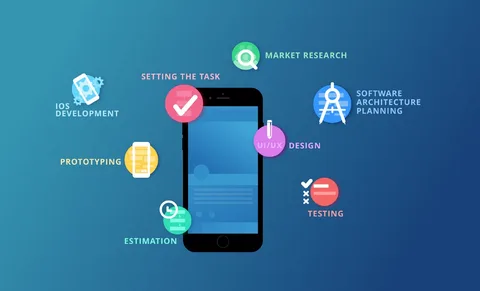
Role of Android App Development in Building Android Apps from scratch
The Android app development has become a thriving industry globally. Having exclusive features such as, a robust data management process, automation system, security, accessibility, and multitasking, the Android operating system is widely used by app development companies. Android Studio is the main component of Android app development that integrates with other testing tools and resources. A robust and quick development environment (IDE) assists app developers in the creation and designing of native Android apps. During the development process, an Android app developer should focus on building MVP features. It helps them know the essential features to be incorporated within the app. The designing phase includes using UI/UX designs to create visually pleasing and intuitive user interfaces that enhance the app’s usability.
The Android app development kit ensures high-quality app testing, debugging, and deployment of the Android apps. The development tools identify bugs and other defects during application development and efficiently fix the errors to let the application function appropriately. Since Android apps are built with object-oriented languages such as Java, Kotlin React Native, and Dart, they develop numerous applications using a single base code. These Android apps seamlessly operate on different networks and devices. With a high-feature operating system platform, Androids creates high-performing applications that are compatible with various operating systems.
iOS App Development Process
An experienced iOS developer employs Swift programming language, and Objective-C to write codes to create iOS apps. They require Xcode, an integrated development environment (IDE), and an Apple Developer account that is installed on the App Store. The iOS app creation process involves using wide-ranging iOS tools and resources such as native APIs and library kits. The iOS SDK platform tools smoothly integrate the iOS app into Apple’s structure and workflow. Moreover, mobile SDK improves the cloud-based capacity of the app, ensuring secure data storage, fast database management, and app caching.
iOS app development involves two programming languages Objective-C and Swift to create a simple and legible syntax for app creation. Both these programming scripts share runtime in programming allowing developers to integrate legacy codebase into iOS apps. Employing UI/UX design helps in creating an outstanding user interface along with other components, screen colors, themes, and animation that boost user’s interaction with iOS apps. iOS developers use IDE testing components for app testing and debugging process. IDE consists of automated UI testing tools, a Code Editor, a Debugger, an Interface Builder, and a testing engine that leads to smooth coding and protects the app from bugs.
Cross-Platform App Development
If you desire to create numerous applications using one-time code that seamlessly operates on different devices and networks. In such a case, employing cross-platform mobile app development is the most suitable choice framework that assists you in establishing robust and high-speed cross-platform apps.
Cross-platform app developers use numerous programming scripts such as Dart, C#, JavaScript HTML, JavaScript, and CSS to write a single code. The code reusability feature helps developers create several apps using a particular code. Utilizing a simple and one-time code allows the apps to operate on multiple platforms efficiently. The cross-platform apps having a single codebase reach to app market more swiftly and are easily accessible by users.
Using specialized cross-platform frameworks such as React Native, Flutter, and Xamarin assists app designers in planning and designing a unique prototype with advanced features. Thus, creating practical, and functional cross-platform applications leads to rapid app development, decreases development costs, and expedites the app release process.
Programming Languages Facilitates in Application Coding
Selecting an appropriate programming language for app creation implies system programmers and coders know various programming scripts used for writing programming codes. It includes using Swift, Objective-C, Native C/C++, and JavaScript for creating iOS and Android applications. Other programming languages such as Dart, Perl, and Python are widely used by app developers to write simple and comprehensible codes to create visually pleasuring user interfaces and other components. Dynamic and agile languages have code readability features that have eased the app creation process. The programmers write one-time code that helps create several applications that seamlessly run on multiple platforms. Platform-independent languages comprising Java, Python, C#, and JavaScript include extensive libraries and frameworks that bring flexibility in writing scripts and modifying the codes. The coding experts write the simplest commands and statements that can be altered and reused to create new applications. Hence, applying agile programming language features including easy-to-understand syntax, and other significant features develops high-quality, robust applications for prospective clients.
Design (UX) and (UI) User Interface
UI design demonstrates the process of creating an elegant and captivating interface and layout of the application. UX and UI designers develop wireframes and prototypes comprising exceptional UI design, colors and themes to be incorporated into the user interface. Visual Design also includes designing navigational buttons and other clickable components. The designers analyze the color patterns of the screens, and layout and ensure color compatibility that engages users. Moreover, using appropriate fonts and adding animation, topography, and other visual components increases the app’s usability and function. Thus, visual components bring a meaningful and user-friendly navigation experience for users.
Testing and Debugging
App testing relates to the process of evaluating an app’s performance before it gets released in the market. Mobile app testing involves constant testing of app components during the development phase. A systematic and controlled testing procedure evaluates app functionality, performance, and speed.
Core testing features comprising unit tests and integration tests engage in comprehensive testing. Beginning with a broad testing plan, a test specialist examines the testing approaches, resources, and tools used for testing. The production process implicates the accuracy of testing data. From testing the app design, code review, and functional testing, the engineers collaborate with product design teams to create controlled testing environments. The testing experts perform various tests such as performance testing that assess how the app performs on different operation systems. The integration testing process allows the testing team to check architectural defects, ineffective app designs, and coding errors. Security testing allows testing professionals to check security vulnerabilities. Identify bugs, viruses, and other malicious activities that cause damage to the app’s stability and functionality. Thus, high-quality mobile application testing procedures ensure robustness and better testing outcomes.
Deployment and Distribution
Once the application gets ready to be launched in the market, the app marketers facilitate developers and publishers in upsurging the app’s marketing and promotion. Business application developers create an app launch marketing plan that increases the application visibility among potential clients. The initial launch strategy involves two possibilities for mobile app deployment. The app can be installed through an app store or using a URL or a direct download link. The users also conveniently download or install numerous apps through browsing websites.
The next part of the app launch strategy analyzes the existing mobile app marketing approaches and employs innovative app marketing trends that attract users. The marketers initiate promotional events that boost app branding. It includes incentivizing customers, offering them pre-order discounts, and distributing coupons and vouchers. Online branding involves businesses to launch marketing campaigns on social media, email, and online sites. Using podcasts, blogs, and striking visuals boosts user engagement with the app.
Learning Resources
App developers have numerous options to enrich their app development skills and learning. It includes having access to online resources such as attending educational programs and online courses that offer knowledge on how to build high-performing applications. Moreover, the users keep abreast with technological advancements in the app development market.
The other learning resources comprise joining online platforms, mobile app development services, and virtual learning environments. These digital services organize seminars, workshops, and online lectures that provide practical tasks, and also offer hands-on experience to new app developers to build unique mobile apps. Hence, innovative marketing approaches influence a broad audience toward the app.
Recapitulate
If you are a new mobile app developer and intend to create robust apps that are compatible with different devices and networks. In such a case, you are required to gain significant knowledge of app development procedures. An essential component of app development is mobile app architecture. It refers to app structure, designing, writing programming codes, and analyzing other app components. Different layers of mobile app architecture such as the presentation layer, business logic, and data layer interact with each other to handle data processing and management. The other function of architecture patterns includes improving the coding of mobile apps and creating striking user interfaces that provide a smooth navigation experience to users. Architecture models ensure app compatibility. It implies programmers gain knowledge of Android, iOS, and cross-platform frameworks and identify the right framework that helps create highly compatible apps that operate smoothly on multiple networks. Another key element of mobile app architecture is to create interactive user interfaces and other visual components. The app testing ensures that architecture patterns improve the performance of app components and enhance the scalability of the app. The evolving changes in app development have influenced software development firms to incorporate modern mobile architecture designs to develop distinctive apps. Moreover, robust mobile app architecture boosts the market reach and usability of the app. More app downloads, installs, and other promotional events increase the market visibility of the app.

